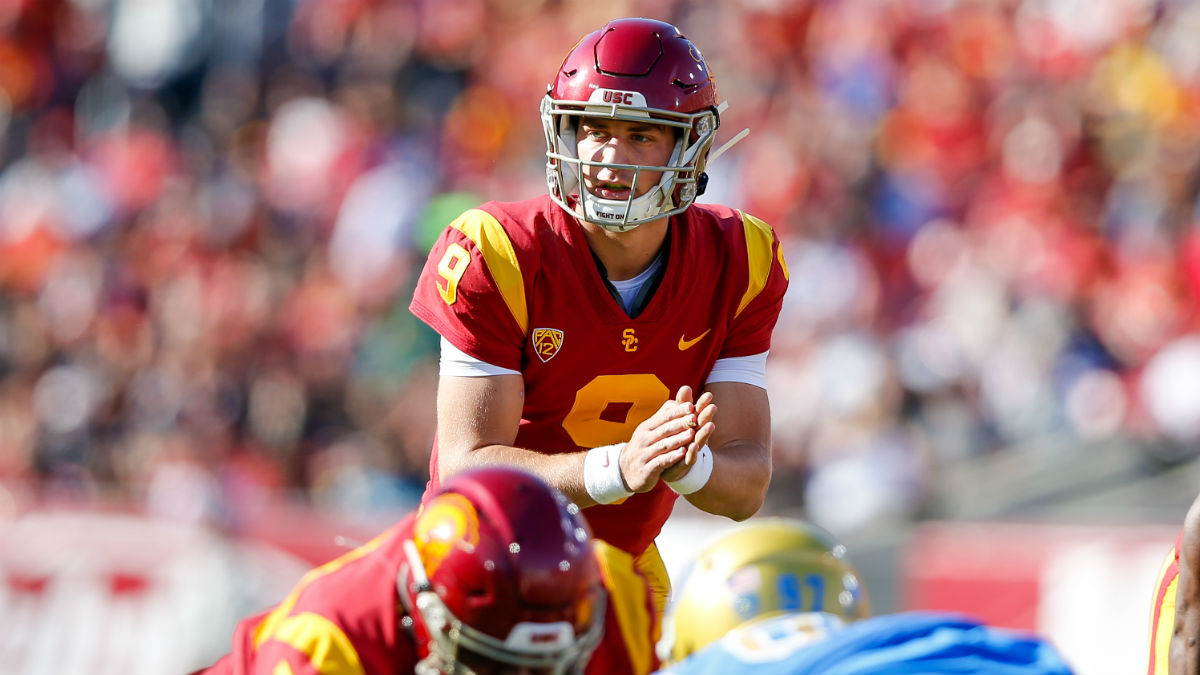Wilson: How I Adjust My College Football Power Ratings & Early Observations for 2020
Jordon Kelly/Getty Images. Pictured: Kedon Slovis
One of the hardest lessons I learned from college was about double checking my work. There were plenty of long Fayetteville nights spent in the basement of Bell Engineering Hall punching cards as a method of writing computer code.
As I updated my College Football Power Ratings for the first time in 2020, double checking my math had a similar feel to the punch card days. I had to make sure everything was right, because there were some big changes.
Before we get to the eye popping numbers in the top 25, the surge of the Big Ten basement and the state of Michigan's downward spiral, it is important to discuss the numbers behind each category.
While many other power ratings are influenced mainly by returning production, I use several categories to adjust a team's stock. Second-Order Win Total, coaching changes, rating regression to the mean, and net turnovers represent just a few of the items in consideration to move an FBS squad.
The next logical step is to assign power ratings to the 2020 schedule, factor in some home-field advantage and produce a win total for all 130 teams.
First, let's take a look at each individual category I mentioned above and the new overall number entering spring practice.
2020 College Football Power Ratings & Adjustments
Defining the Categories
First, I'll start with last season's power rating. Not much stock is given to the results of bowl games or National Signing Day, though.
Next I'll outline regression toward the mean, which is designed to identify an outlier season that strays far from a team's normal output. Notre Dame completed 2016 with a 4-8 record and a power rating more than 20 points from its historical average. The Irish would pop back to make the College Football Playoff just two years later, showing why you can never adopt a previous season power rating.
This past season, UMass and LSU represent the two extremes. The Minutemen and Tigers exceeded their historical rating by more than 20 points.
In general, a conference has a range of power ratings that are predictable. When a team exceeds that conference medium, there is always room for regression. Both UL Lafayette and Navy performed above their respective conference range, for example.
Navy QB Malcolm Perry now holds the FBS record for most rushing yards in a single season by a QB with 2,017 yards.
His 155 rushing yards per game is also the most ever in a single season by a QB.
He has also rushed for 100+yards in 10 straight games
— Cole Cubelic (@colecubelic) January 1, 2020
Next I'll take a look at Second-Order win total, which is the examination of a team's post-game win expectancy compared to how many games they actually won.
Miami of Ohio was the biggest benefactor of winning games with a negative win expectancy. The new power rating considers how lucky a team got the previous year, and normalizes it for the next season.
Listing returning starters can be a lazy way of identifying what a team has coming back. Returning production grades the value of an experienced secondary, offensive line and receiving targets. Offensive returning production can swing a rating seven points in either direction, while defensive returners can swing a rating five points.
For example, Cal is the number one team in offensive returning production, generating a positive bump of seven points. Utah has the lowest returning production rate on defense, generating a negative bump of five points.
But never forget, Vegas and New Jersey oddsmakers take notice of returning production more than any other category before posting college football futures.
Grading head coach and coordinator changes is a bit less analytical. SportSource Analytics does a great job in evaluating coaches from every angle, including success rate in formations on both sides of the ball.
The data suggests Nick Rolovich was a perfect fit at Washington State, Joe Moorhead will increase Oregon's offensive efficiency and Ricky Rahne may struggle at Old Dominion. Even as of this writing, Mel Tucker's decision to leave Colorado for Michigan State will adjust both teams power rating.
Net turnovers also play a part of adjustment. Florida Atlantic and Alabama were two of the more fortunate teams last season. USC, Duke and Purdue are prime candidates to positively regress after an unfortunate 2019 season in turnovers.
The Biggest Winners and Losers
The mass exodus of players from LSU was expected after winning a national championship. Negative marks in second-order win total, net turnovers and rating regression have the national champions deflated to the bottom of the top 10. Because Joe Brady was the most famous passing game coordinator in college history, the addition of Scott Linehan will be trial by fire for LSU fans.
Western Michigan is another team that turned up negative marks in every category. This is a program that is used to being built up and torn down through the Bill Cubit, PJ Fleck and Tim Lester regimes. The Broncos lose plenty from an offense that was top 40 in passing success rate and top 20 in rush explosiveness. Lester will go down the transfer route to plug holes in 2020.
At the opposite end of the spectrum, welcome Rutgers and Northwestern as the clubhouse leaders in positive power rating adjustment. Northwestern returns every player to a historically bad offense that generated one of the worst second-order win totals and turnover margin. Rutgers hiring Greg Schiano made the most sense from a program rebuild and recruiting aspect.
Very nice pick-up for Greg Schiano: Wisconsin WR-KR Aron Cruickshank is transferring to #Rutgers.. Dynamic little playmaker is one of the nation's top returnmen.
— Bruce Feldman (@BruceFeldmanCFB) January 18, 2020
A team that hit positives across the board was Purdue. Three different quarterbacks made at least 100 passing attempts, while star receiver Rondale Moore spent most of 2019 dealing with injury. The emergence of wide receiver David Bell with 89 catches for more than a 1,000 yards will make the Boilermakers must see television this fall.
So, seriously, @BoilerFootball's gonna have David Bell *and* Rondale Moore next season. 😱
Good luck, B1G secondaries! pic.twitter.com/pCwtxDqlrR
— Purdue On BTN (@PurdueOnBTN) December 1, 2019
Surprises in the Top 5
This season will be labeled as who can join Ohio State and Clemson in the College Football Playoff. Wisconsin had positive returning production and second-order win total, but took a minor hit for rating regression. The Badgers don't have to play Ohio State, and may be just a Michigan victory away from making the Big Ten Championship a national quarterfinal game. Wisconsin returns the bulk of a defense that ranked second in the nation in havoc.
The general consensus around USC is that 2020 is a boom-or-bust season for all parties involved. Clay Helton was retained and subsequently made plenty of changes on defense.
Somehow rising star offensive coordinator Graham Harrell is still on campus after flirting with jobs in the NFL. The Trojans were a top 25 team in offensive success rate, as 2020 sees the return of freshman quarterback Kedon Slovis and most of his targets.
Helton will kickoff the season against Alabama in Arlington, a game we project the Crimson Tide as a 1-point underdog.
How would you rate this article?




